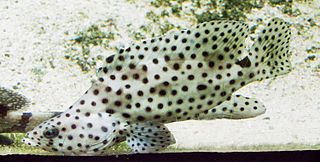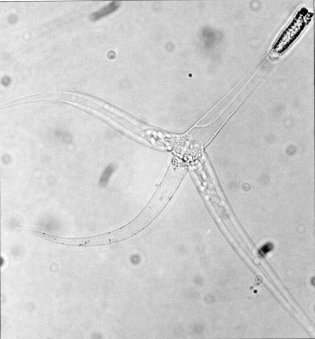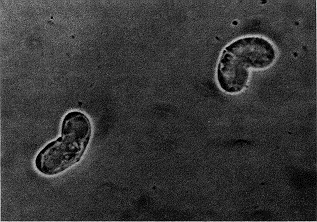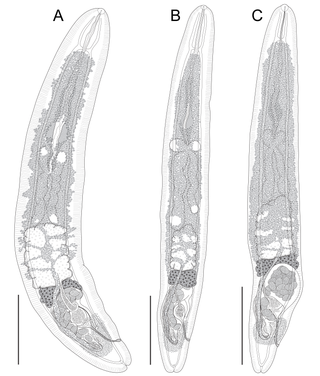
The Serranidae are a large family of fishes belonging to the order Perciformes. The family contains about 450 species in 65 genera, including the sea basses and the groupers. Although many species are small, in some cases less than 10 cm (3.9 in), the giant grouper is one of the largest bony fishes in the world, growing to 2.7 m in length and 400 kg (880 lb) in weight. Representatives of this group live in tropical and subtropical seas worldwide.

Myxozoa is a subphylum of aquatic cnidarian animals – all obligate parasites. It contains the smallest animals ever known to have lived. Over 2,180 species have been described and some estimates have suggested at least 30,000 undiscovered species. Many have a two-host lifecycle, involving a fish and an annelid worm or a bryozoan. The average size of a myxosporean spore usually ranges from 10 μm to 20 μm, whereas that of a malacosporean spore can be up to 2 mm. Myxozoans can live in both freshwater and marine habitats.

Myxosporea is a class of microscopic parasites, belonging to the Myxozoa clade within Cnidaria. They have a complex life cycle which comprises vegetative forms in two hosts, an aquatic invertebrate and an ectothermic vertebrate, usually a fish. Each host releases a different type of spore. The two forms of spore are so different that until relatively recently they were treated as belonging to different classes within the Myxozoa.

Ceratonova shasta is a myxosporean parasite that infects salmonid fish on the Pacific coast of North America. It was first observed at the Crystal Lake Hatchery, Shasta County, California, and has now been reported from Idaho, Oregon, Washington, British Columbia and Alaska.

The ring-tailed cardinalfish is a widespread fish species in the family Apogonidae found in the Red Sea and off East Africa to Papua New Guinea, north to Japan, and south to Australia.

Ostorhinchus cyanosoma, commonly known as the yellow-striped cardinalfish, goldenstriped cardinalfish, or the orange-lined cardinalfish, is a species of marine fish in the cardinalfish family of order Perciformes. It is native to the Indo-West Pacific.
Ceratomyxa is a genus of myxozoan.

Kudoa is a genus of Myxozoa and the only genus recognized within the monotypic family Kudoidae. There are approximately 100 species of Kudoa all of which parasitize on marine and estuarine fish. Kudoa are most commonly known and studied for the negative effects the genus has on commercial fishing and aquaculture industries.
Kudoa whippsi is a myxosporean parasite of marine fishes, first discovered in Australia from 8 pomacentrid species and 1 apogonid species.
Kudoa paraquadricornis is a myxosporean parasite of marine fishes, first discovered in Australia from 4 carangid species.
Ceratomyxa brayi is a species of myxosporean parasites that infect gall-bladders of serranid fishes from the Great Barrier Reef. It was first found on Cephalopholis boenak.
Ceratomyxa cutmorei is a myxosporean parasite that infects gall-bladders of serranid fishes from the Great Barrier Reef. It was first found on Epinephelus fasciatus.
Ceratomyxa gleesoni is a myxosporean parasite that infects gall-bladders of serranid fishes from the Great Barrier Reef. It was first found on Plectropomus leopardus.
Ceratomyxa hooperi is a myxosporean parasite that infects gall-bladders of serranid fishes from the Great Barrier Reef. It was first found on Epinephelus quoyanus.
Ceratomyxa whippsi is a myxosporean parasite that infects gall-bladders of serranid fishes from the Great Barrier Reef. It was first found on Cephalopholis boenak.
Ceratomyxa yokoyamai is a myxosporean parasite that infects gall-bladders of serranid fishes from the Great Barrier Reef. It was first found on Epinephelus maculatus.
Ceratomyxa elegans is a species of myxozoans. It is found in the Mediterranean and the Argentinian Seas. It is a parasite of Batrachoidiform toadfishes.

Aporocotylidae is a family of trematodes within the order Diplostomida, which contains species commonly known as fish blood flukes. It contains more than 40 genera, the largest being Cardicola. Species in this family parasite fish in both fresh and marine water.
Pseudorhabdosynochus youngi is species of diplectanid monogenean parasitic on the gills of the blacktip grouper, Epinephelus fasciatus. It was described in 2009.
Ceratomyxa auratae is a species of myxozoan parasite that infects the gall bladder of the gilthead seabream, Sparus aurata. It was discovered in an aquaculture facility in southern Portugal.







